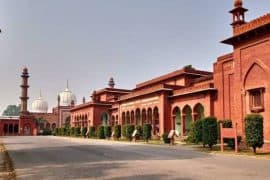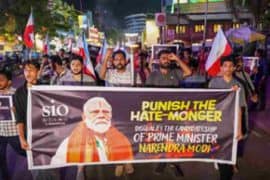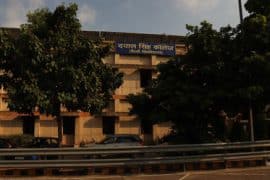With an overwhelming abundance of saffron flags and Jai Shree Ram chants across the North Campus of Delhi University, students have their opinions divided over the future of sanctity of educational spaces.
22nd of January, 2024 saw the North Campus of Delhi University wrapped in saffron. Saffron flags, streamers, sashes, ‘tilaks’ adorned every corner of the campus. Imprinted on them were the signs of ABVP, Akhil Bharatiya Vidyarthi Parishad, the student-wing of RSS, along with images of Lord Ram and slogans of ‘Jai Shree Ram’. Diyas spelled out as ‘Hindu Rashtra’ and a giant poster of ‘Jai Shree Ram’ marked the entrance to the Arts Faculty of Delhi University. Bhajan Mandali, LED-screens live screening the Ayodhya ceremony, community kitchens as well as a miniature structure of the Ram Mandir was established within the campus to emulate the celebrations at Ayodhya.
The Pran Pratistha Ceremony at Shri Ram Janmabhoomi Temple, Ayodhya was a truly historic moment, one that generations have waited for. We have been fortunate to witness it live with our eyes. The students of Delhi University, like the rest of the nation, were beyond themselves with joy on this occasion. The constant slogans of Jai Shree Ram during the screening held at North Campus, the hawans in various colleges, all tell us how emotional the student fraternity was about the event. Lakhs of diyas were lit across the North and South Campus, and the off-campus colleges, and the turnout for the same was completely spontaneous, especially that for more than 2.5 lakh diyas being lit at the North Campus, Chhatra Marg and the law faculty with students turning up in large numbers for them.
-Ashish Singh, State Executive Member of ABVP.
While the celebrations continued, the student community within Delhi University is divided on the connotations behind this saffron wave. Contrarily, the Faculty of Law saw the Tiranga wave on 23rd January.
“The students of the Faculty of Law conducted an event emphasising the ideas in our Preamble as well as the Indian Constitution. The event was in contrast to the politicisation of the Ram Mandir celebration by ABVP with communal slogans of ‘Kaashi Mathura Abhi Baaki Hai’ and writing ‘Hindu Rashtra’ with diyas. Like our nation, our campus is also a diverse space with students from different backgrounds enriching it and the Law Faculty event highlighted that the flag of no other ‘sangathan’ is above our Tiranga at the end of the day.”
-Hitesh Kumar, state executive member of SFI.
The three-day event conducted at the Faculty of Law since the 23rd of January saw preamble readings, marches, speeches by advocates emphasising the ideals engrained within the Preamble of the Constitution.
However, as ABVP flags overwhelmed both the campuses of Delhi University on the 22nd of January, the absence of alternate student parties’ inclusion in the celebration was alarming. Like the nation, the lack of opposition at a national event like the Ayodhya celebration led to a political showdown of saffron and ‘Jai Shree Ram’. In response to claims why the Faculty of Law event was not conducted on 22nd itself, a member of SFI says that:
We did not want to interrupt the ABVP event as the sentiments of general students would have been hurt. Anything beyond the Pran Pratistha event would have been marked as an act against a particular religion, which we are not. The Faculty of Law event was not a reactionary one. It’s the need of the time that we should remember and embrace the secular, democratic, socialist ideas enshrined in our constitution.
“We have all witnessed the saffronisation of buildings, universities and streets just before the 2024 Lok Sabha elections and we have taken up a nationwide campaign, ‘Modi Sarkar Ke Dus Saal’ to gauge the real issues concerning the nation like unemployment and we conducted preamble readings across DU campuses at a prime time when the constitution of India is under blatant attack and the campus is being communalized.”
-Anjali, AISA DU Secretary.
While several perspectives crop up with respect to the University embracing ‘religious symbols’ on the 22nd of January, several questions remain to be answered by the student fraternity. Should university grounds be open to embracing religious connotations? Has religion become a politicised tool in the campus and the country today? Where do we draw the line between religion and culture today?
Public-funded educational spaces must not have such blatant display of religious ceremonies. If you take a walk around Arts Faculty, Ram Mandir and bhagwa flags take over the Indian flag and this can occur only if the administration is involved along with DUSU, which is dominated by ABVP. We have requested the Dean of Arts Faculty to take down the saffron flags at our campus to let our campus be a secular space.
-Aditi, SFI DU Convenor.
With the introduction of the National Educational Policy, subtle saffronisation of public education had taken it’s roots with Hindu Studies being introduced as a major, removal of Islamic thinkers from undergraduate syllabus as well as introducing subjects like Fit India, Horoscope Reading as skill-enhancement courses. However, the Pran Pratistha Ceremony of 22nd of January, let loose the gradually boiling saffronisation and unveiled it in the open.
Cultural ceremonies pertaining to the feats of Lord Ram, Bhajan Mandalis concerning Lord Ram and slogans of ‘Ram Mandir se Ram Rajya Tak’ were heard across North Campus with hundreds of devotees gathered round. While streaks of saffron crawled through our education space previously, 22nd of January marked a saffron-tsunami for DU. And the most alarming part lay in the lack of alternative voices within the campus. This brings along another important question, is our campus still a safe-space to provide alternate views? Or will only the way of the saffron community exist from now on?
While the Hindutva debate rages on, right-wing parties often claim the salience of being a Hindu as a geographical identity, much beyond the boundaries of religion and culture. Hindutva is seen as a force of unity, a reason of national pride.
Opposing the claims of ‘communalism’ propagated by ‘Hindu Rashtra’ written using Diyas within North Campus, a state-executive member of ABVP notes that:
In our understanding, Hindu Rashtra is not a symbol of communalism, it is a geographical concept. Even if this particular word was written, there is nothing wrong in it. It is the origin of various names our country is known by like India and Hindustan.
Another perspective that must be noted in the Ram Mandir celebration was the mass number of students who turned up. Colleges across DU noticed tides of students turning up to embrace the celebration, in various ethnic attires and saffron sashes, which depicts where the sentiments of the student fraternity are mostly inclined today.
While debates rage on if the Ayodhya celebration was used as a mass-politicised tool, the association of Ram Janmabhoomi with saffron-right wing flags rather than national flags paints an all together different picture. Ram Mandir celebrations have been localized only for right-believers, as the ABVP symbol conjugated with ‘Jai Shree Ram’ flags suggests. To what extent must religion go hand in hand with politics? To what extent must religion be allowed to enter secular educational spaces?
While controversies and discussions run around in this heated political climate, we need to gauge some important answers, is the Ram Mandir celebration a symbol of United India or of Hindutva Dominance? While the national as well as campus community remains divided upon the answer, Naya Bharat aka Naya DU is rapidly reshaping itself as per majority sentiments!
Read Also: Saffronisation of Cultural Expression
Featured Image Credits: Ankita Baidya For DU Beat
Priyanka Mukherjee





Comments are closed.